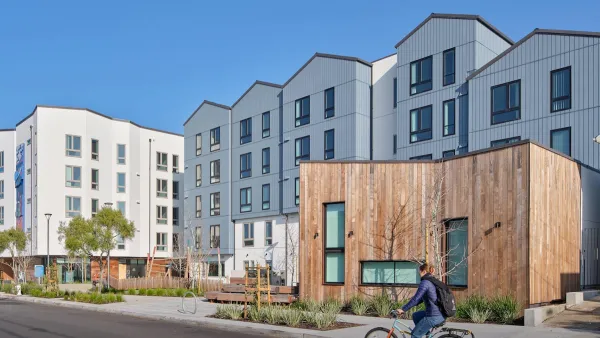Milan's six-month-old congestion charge, indirectly authorized by public referendum and by all measures successful in reducing traffic, crashes, and pollution, has been brought to an abrupt end by the successful appeal of a parking garage owner.
The Council of State, an administrative court, upheld the parking garage's right to appeal, thus eliminating the "charge of 5 euros, or about $6, to drive into the city's core."
The ruling, while "embraced by many businesses in the affected area," was met with anger by environmental groups and cycling lobbies, saying that it suspended what had been a strong effort to improve the air quality and livability of one of the most traffic-clogged and polluted cities in Europe."
Elisabetta Povoledo writes that "traffic is Public Enemy No. 1 in Milan, where it is estimated that 730,000 vehicles, including 460,000 driven by people who live outside the city, circulate each day, jamming its historic streets and slowing public transportation."
"For now, proponents of the fee are emphasizing that the court based its ruling on a procedural matter, not merit, and in November a regional administrative court will rule on whether the parking lot's claims are justified."
Regulating emissions or traffic - different paths taken by city administrations:
"The previous center-right city administration had set some limits, banning cars that fell below certain emissions standards, but after residents overwhelmingly voted in a referendum to diminish the use of private cars, the current center-left government introduced the congestion fee."
Fee opponents noted motorists purchased cleaner cars after the initial ban, and that SUVs and cars would pay the same 6 euro congestion charge.
Planetizen notes that Milan initiated a congestion pricing program in January, 2008.
FULL STORY: Effort to Cut Milan Traffic Halted as Court Favors Garage

Planetizen Federal Action Tracker
A weekly monitor of how Trump’s orders and actions are impacting planners and planning in America.

San Francisco's School District Spent $105M To Build Affordable Housing for Teachers — And That's Just the Beginning
SFUSD joins a growing list of school districts using their land holdings to address housing affordability challenges faced by their own employees.

Can We Please Give Communities the Design They Deserve?
Often an afterthought, graphic design impacts everything from how we navigate a city to how we feel about it. One designer argues: the people deserve better.

The EV “Charging Divide” Plaguing Rural America
With “the deck stacked” against rural areas, will the great electric American road trip ever be a reality?

Judge Halts Brooklyn Bike Lane Removal
Lawyers must prove the city was not acting “arbitrarily, capriciously, and illegally” in ordering the hasty removal.

Engineers Gave America's Roads an Almost Failing Grade — Why Aren't We Fixing Them?
With over a trillion dollars spent on roads that are still falling apart, advocates propose a new “fix it first” framework.
Urban Design for Planners 1: Software Tools
This six-course series explores essential urban design concepts using open source software and equips planners with the tools they need to participate fully in the urban design process.
Planning for Universal Design
Learn the tools for implementing Universal Design in planning regulations.
Borough of Carlisle
Smith Gee Studio
City of Camden Redevelopment Agency
City of Astoria
Transportation Research & Education Center (TREC) at Portland State University
City of Camden Redevelopment Agency
Municipality of Princeton (NJ)


























